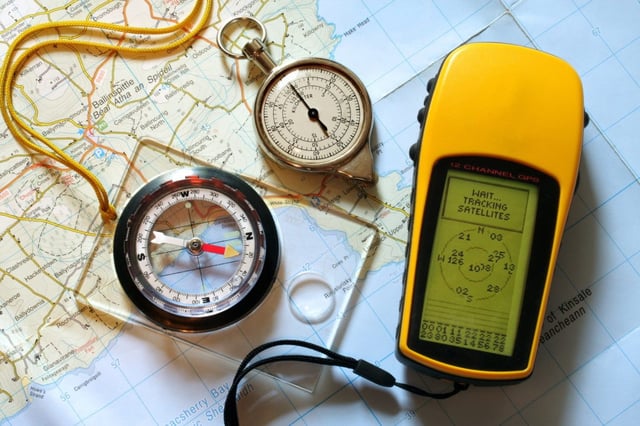Although it was firstly envisioned for military use, the GPS (Global Positioning System) was the first GNSS system that was free to use by civilians. It was launched in 1970 by the DoD (Department of Defense), while its first Initial Operational Capability (IOC) was achieved in 1993. With a constellation of 24 to 32 satellites, GNSS positioning provides global coverage nowadays.
How GNSS Positioning Finds Its Place On Today's Market
Today's GNSS technology market is a massive, multi-billion dollar industry. Applications range from simple handheld meter-level navigation aids, to centimeter-level exact positioning solutions for survey, unmanned, and military applications. GNSS technology is also being integrated with inertial technology to enhance positioning capabilities and dependability.
The accuracy of GNSS has grown with time. In 2000, when Selective Availability (SA) was switched off, its accuracy increased from 100 to less than 10 meters, which proved extremely useful for civil usage. The accurate time and position that GNSS receivers provide has enabled technologies and mass-market applications, such as the synchronization of power grids, financial networks, and cellular systems, among many others.
The first non-military applications of GNSS technology were in surveying and mapping. Today, GNSS is being used commercially in transportation, agriculture, unmanned vehicle operations, machine control positioning, and many other industries that can benefit from the application of precise position and time information.

Apart from these applications, GNSS is also used in consumer vehicle navigation, mobile communications, entertainment, and many other areas that are yet to be developed or conceived for its use as technology is becoming more affordable and easy to use.
Regarding machine control, GNSS technology is being integrated into equipment such as bulldozers, excavators, graders, pavers, and farm machinery to enhance productivity and provide situational awareness information to the equipment operator.
Some of the benefits of GNSS-based machine control are:
Easier Job Coordination and Better Management
Site managers and contractors have access to accurate information about their job site. GNSS provides remote access and overview of this type of information.
Increased Accuracy
The precision offered by GNSS minimizes the need to cease work while a survey crew is measuring the grade.
Maximized Efficiency
GNSS helps in speeding up work immensely. It also reduces capital and operating costs by helping the equipment operator get to the desired grade in as little time as possible.
Management of Data
GNSS enables you to generate and print status reports. You can also save important data and easily transfer files.

Agriculture Applications
GNSS applications are also commonly used for farm planting support, soil sampling, tractor guidance, and the assessment of crops. Moreover, using GNSS reduces costs and the negative impact on the environment. Farmers can use GNSS to automatically guide farm implements, control erosion, and maximize the efficiency of their irrigation systems. They can also operate machinery day and night with high accuracy and increased safety.
Unmanned Vehicle Applications
GNSS is known to be applied in unmanned vehicle operations, too. Unmanned vehicles are vehicles that are unoccupied, but under human control. They are either radio-controlled or automatically guided by GNSS-based devices. Initially, they were used solely by the defense industry, but with the rising popularity of drones and other unmanned aerial vehicles, ordinary citizens have also begun using them.
However, the use of unmanned vehicles by ordinary citizens is not confined to drones. The unmanned vehicle market has grown massively over the past several years and the commercial use of unmanned vehicles has also grown and diversified.
Some of the current civilian uses for unmanned vehicles include: search and rescue, conservation of wildlife, crop monitoring, aerial photography, environment research, inspection of infrastructure, HAZMAT inspection, and crisis and disaster management.
Detection of Theft and How GNSS Technology Works
GNSS lets you create a “virtual fence” around your equipment and property. Hence, the equipment will automatically raise an alarm when it is being removed, and will provide tracking information to the authorities.
How Hemisphere GNSS Can Help You
It goes without saying that productivity and efficiency increase significantly with the use of GNSS technology. Hemisphere GNSS offers a variety of products, services, and solutions that serve many industries with this technology - machine control being one of them.

The high-performance of our GNSS satellite positioning solutions is able to withstand some of the most demanding and hazardous environments (i.e. freezing cold and / or very hot temperatures).
If you are in the construction industry, we offer top-of-the-line machine control components available for your dozer, excavator, grader, or other heavy machinery. Moreover, we have high-performance satellite positioning solutions that can be tailored to your needs.
The competitive pricing doesn't mean our solutions skim in quality. On the contrary, the affordable prices, coupled with the high quality technology utilized, make us a fantastic choice for your satellite positioning needs.
The way GNSS satellites work is straightforward. Typically, there are 6-12 satellites visible above the horizon, at any given time, which the receiver tries to track. If some (satellites) are blocked by tall buildings or other objects, the receiver automatically tries to reacquire the blocked signals.
A GNSS receiver usually needs a minimum of four satellites to provide a 3-dimensional (latitude, longitude, and altitude) solution. However, it can maintain a latitude-longitude position using just three satellites.
Requiring four satellites is one of the potential limitations of using GNSS, since signals could be blocked by tall trees and buildings, and other large objects. Moreover, GNSS can’t be used indoors, although this was never the main purpose of GNSS in the first place. The proliferation of handheld devices with built-in GPS renders the use of GNSS indoors meaningless.
GNSS constellations are designed to provide (worldwide) positioning services with an accuracy ranging from 5 to 15 meters. Higher precision accuracies are not possible with standard GNSS due to minor timing errors and satellite orbit errors. These accuracies are also impossible in atmospheric conditions that affect the signals and their Earth arrival time.
Having machine control positioning provided by professionals, like the ones at Hemisphere GNSS, helps in maximizing the efficiency of your operations. We can also show you how to lower your costs, reduce fuel consumption and idling hours, and offer you a safe working environment for both you and your employees.



